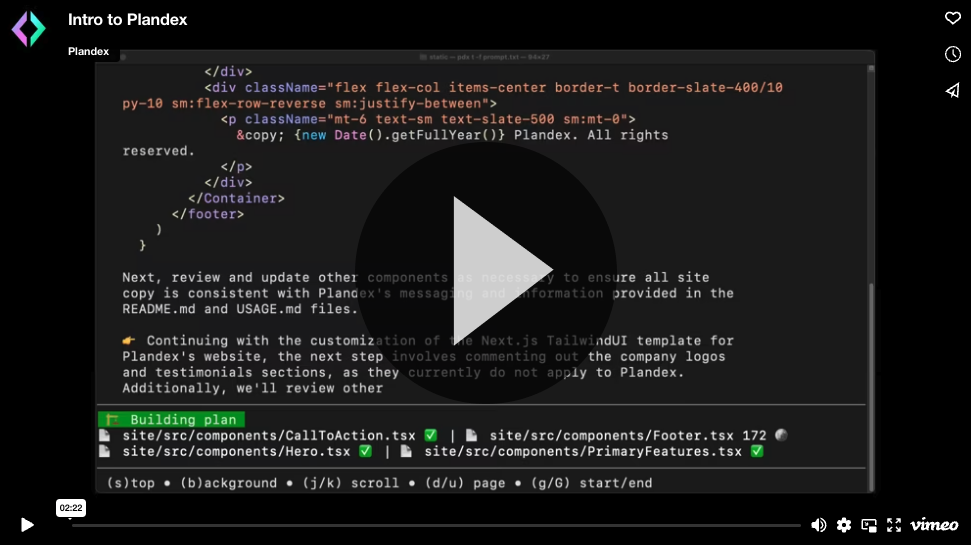
- Overview
- Install
- Get started
- Docs
- Build complex software
- Why Plandex?
- Roadmap
- Discussion and discord
- Contributors
Churn through your backlog, work with unfamiliar technologies, get unstuck, and spend less time on the boring stuff.
Plandex is a reliable and developer-friendly AI coding agent in your terminal. It can plan out and complete large tasks that span many files and steps.
Designed for real-world use-cases, Plandex can help you build a new app quickly, add new features to an existing codebase, write tests and scripts, understand code, and fix bugs.
curl -sL https://plandex.ai/install.sh | bashNote: Windows is supported via WSL. Plandex only works correctly on Windows in the WSL shell. It doesn't work in the Windows CMD prompt or PowerShell.
Plandex uses OpenAI by default. If you don't have an OpenAI account, first sign up here.
Then generate an API key here and export it.
export OPENAI_API_KEY=...Now cd into your project's directory. Make a new directory first with mkdir your-project-dir if you're starting on a new project.
cd your-project-dirThen start your first plan with plandex new.
plandex newLoad any relevant files, directories, directory layouts, urls, or images into the LLM's context with plandex load.
plandex load some-file.ts another-file.ts
plandex load src/components -r # load a whole directory
plandex load src --tree # load a directory layout (file names only)
plandex load src/**/*.ts # load files matching a glob pattern
plandex load https://raw.githubusercontent.com/plandex-ai/plandex/main/README.md # load the text content of a url
plandex load images/mockup.png # load an imageNow send your prompt. You can pass it in as a file:
plandex tell -f prompt.txtWrite it in vim:
plandex tell # tell with no arguments opens vim so you can write your prompt thereOr pass it inline (use enter for line breaks):
plandex tell "add a new line chart showing the number of foobars over time to components/charts.tsx"Plandex will make a plan for your task and then implement that plan in code. The changes won't yet be applied to your project files. Instead, they'll accumulate in Plandex's sandbox.
To learn about reviewing changes, iterating on the plan, and applying changes to your project, continue with the full quickstart.
⚡️ Changes are accumulated in a protected sandbox so that you can review them before automatically applying them to your project files. Built-in version control allows you to easily go backwards and try a different approach. Branches allow you to try multiple approaches and compare the results.
📑 Manage context efficiently in the terminal. Easily add files or entire directories to context, and keep them updated automatically as you work so that models always have the latest state of your project.
🧠 By default, Plandex relies on the OpenAI API and requires an OPENAI_API_KEY environment variable. You can also use it with a wide range of other models, including Anthropic Claude, Google Gemini, Mixtral, Llama and many more via OpenRouter.ai, Together.ai, or any other OpenAI-compatible provider.
✅ Plandex supports Mac, Linux, FreeBSD, and Windows. It runs from a single binary with no dependencies.
🏗️ Go beyond autocomplete to build complex functionality with AI.
🚫 Stop the mouse-centered, copy-pasting madness of coding with ChatGPT.
⚡️ Ensure the model always has the latest versions of files in context.
🪙 Retain granular control over what's in the model's context and how many tokens you're using.
⏪ Rewind, iterate, and retry as needed until you get your prompt just right.
🌱 Explore multiple approaches with branches.
🔀 Run tasks in the background or work on multiple tasks in parallel.
🎛️ Try different models and temperatures, then compare results.
🧠 Support for open source models, Google Gemini, and Anthropic Claude in addition to OpenAI ✅ released
🖼️ Support for multi-modal models—add images and screenshots to context ✅ released
🤝 Plan sharing and team collaboration
🖥️ VSCode and JetBrains extensions
📦 Community plugins and modules
🔌 Github integration
🌐 Web dashboard and GUI
🔐 SOC2 compliance
🛩️ Fine-tuned models
This list will grow and be prioritized based on your feedback.
Speaking of feedback, feel free to give yours, ask questions, report a bug, or just hang out:
⭐️ Please star, fork, explore, and contribute to Plandex. There's a lot of work to do and so much that can be improved.
Work on tests, evals, prompts, and bug fixes is especially appreciated.
